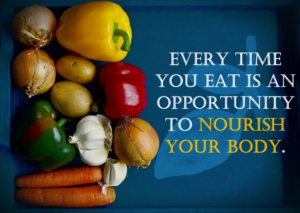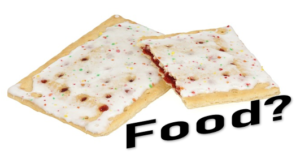 We are surrounded by “food” in everything we do and every part of our lives!
We are surrounded by “food” in everything we do and every part of our lives!
But, have you ever stopped to think about what “food” really is?
Are all of the things we eat really “food?”
The definition of FOOD is “a nutritious substance that maintains life and growth and nourishes, sustains, and supplies.”
To really understand this, we need to know what “nutritious” and “nourishes” mean…
NUTRITIOUS means “providing nourishment; healthful.”
NOURISHES means “to cause something to develop or grow stronger.”
So, “food” is something that provides nourishment, is healthful, and helps us to develop or grow stronger.
We know that a sweet potato stuffed with Mexican flavors such as black beans, corn, tomatoes and avocado is “food.” And there is no doubt that a spinach salad topped with berries, roasted beets, nuts and a homemade dressing qualifies as “food.” Each of the individual ingredients provide nourishment, plus the combination of ingredients working together provides nourishment we can’t even fully understand!
 How many things are we tempted to eat every day that aren’t really “food?”
How many things are we tempted to eat every day that aren’t really “food?”
The nachos at the ballpark concession stand? Not food.
The Pop-Tarts or Lucky Charms (with their multi-colored marshmallows) or the Strawberry Frosted Donut Oreos we saw at the store a few days ago? Definitely not.
The Lean Cuisine Spinach, Artichoke & Chicken Panini (sounds healthful, right)? Sorry to burst your bubble, but it doesn’t qualify as food.
Most carryout and frozen pizzas? Sorry, they don’t meet the definition. These “food-like products” (we can’t really call them “food,” can we?) don’t provide nourishment or help us to develop and grow stronger.
These “food-like products” may even do the opposite!
Many likely cause damage to our bodies and, over time, increase the risk of illness and chronic disease. But wait! What about the claims on the boxes and packages that tell us how nutritious they are?! By now, we all know the processes used to manufacture these products deplete the natural nutrients, so they have to be added back in order to achieve these health claims.
In most cases, health claims are a good sign they are not really “food!” (Seriously, do you ever see health claims on apples or asparagus?!)
What if we don’t eat enough “food?”
We have all read heartbreaking stories about people who are “malnourished.” When we hear this word, we typically think of people who don’t have enough to eat and are suffering from a lack of calories or nutrients. But if you think about it, we also have a significant portion of the population who are “malnourished” not from a lack of calories, but from getting too many of the wrong calories and not enough nutrients.
 It may be hard to believe, but in the 1940s, the armed forces had to reject as many as 40% of recruits because they were malnourished. That is, they were underweight and not getting enough calories and nutrients. This is part of what led to the introduction of the national school lunch program (to get our kids the nourishment they needed). Fast forward to today and 71% of those between 17 and 24 do not qualify for military service, many because of their health. That is, they are overweight and getting too many of the wrong calories and not enough nutrients (in other words, they are not getting enough “food”).
It may be hard to believe, but in the 1940s, the armed forces had to reject as many as 40% of recruits because they were malnourished. That is, they were underweight and not getting enough calories and nutrients. This is part of what led to the introduction of the national school lunch program (to get our kids the nourishment they needed). Fast forward to today and 71% of those between 17 and 24 do not qualify for military service, many because of their health. That is, they are overweight and getting too many of the wrong calories and not enough nutrients (in other words, they are not getting enough “food”).
As springtime approaches, we will soon start planting flowers or a garden, and we will provide “food” to help our plants develop and grow stronger. But, what about the “food” we provide ourselves and our families? The “food” we eat should help us not just survive, but thrive! Of course, this is especially important for our children.
 At Eat REAL America, we talk a lot about eating REAL food.
At Eat REAL America, we talk a lot about eating REAL food.
Technically, we should be able to simply say…Eat FOOD! After all, processed food-like products don’t really meet the definition of “food.”
However, because we don’t typically keep this definition of “food” top of mind all day long, we think it’s much simpler to just remember to “Eat REAL food!” Then, we will be eating foods that provide nourishment and help us to develop and grow stronger. Plus, we think you will quickly realize…it tastes SO MUCH better!
Want some examples of “food-like products” that are marketed as “food,” but really aren’t? Check out the links to some of our other coaching tips like the ones about pancakes, maple syrup, breakfast cereal, donuts, whipped cream, salad dressings, hot chocolate and puddings.
So, the bottom line?
Keep it simple! Eat FOOD! EAT REAL FOOD!
If you know someone who is confused about how to eat healthfully, please feel free to share this with them and encourage them to keep it simple and EAT REAL!




Great information: Every time you eat is an opportunity to nourish your body.
It gives us another tool as we think of food as nourishment. Thanks for sharing.
Thank you for the feedback, support and encouragement!
I always knew that I was not eating as healthy as I should be: but making a conscious effort now to distinguish and choose “real” food over other choices is a game changer and I am beginning to notice the benefits from my choices!
Thank you for the feedback and so proud of your efforts! It definitely is a journey and the benefits will just keep getting better and better!